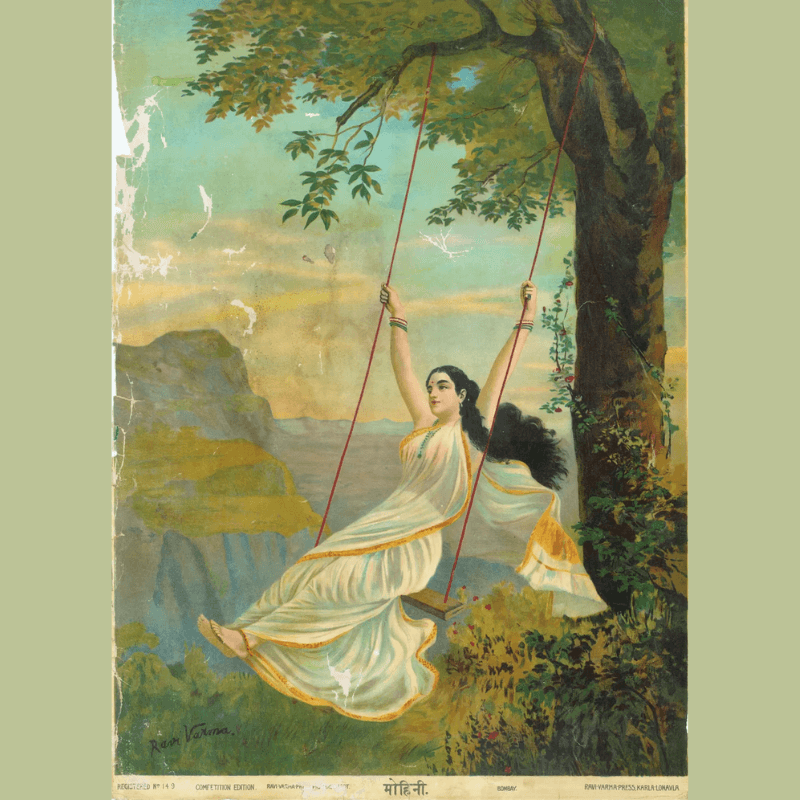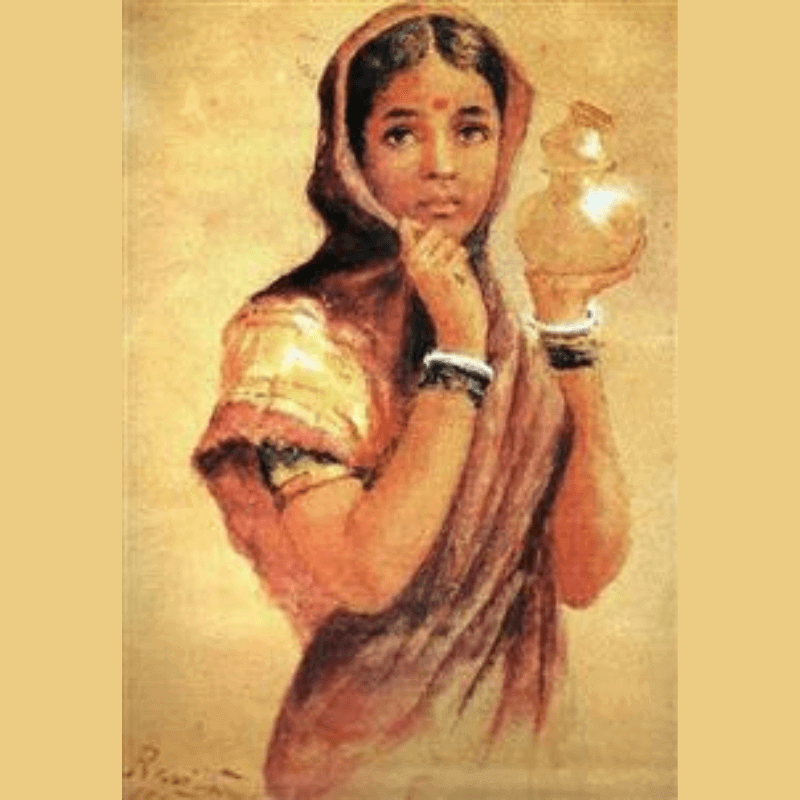
Raja Ravi Varma’s contribution to Indian art is monumental, marking a significant turning point in its evolution and setting the stage for modern Indian art. His work reshaped artistic styles and influenced cultural perceptions and visual representation in India. Read here to learn more about his life.
Raja Ravi Varma (1848–1906) was a celebrated Indian painter and artist, widely regarded as one of the greatest painters in the history of Indian art.
His work is a unique blend of Indian traditions and the techniques of European academic art, and he is known for making Indian mythology accessible to a contemporary audience through his vibrant and realistic portrayals.
Early Life and Background
Born in the princely state of Travancore (in present-day Kerala, India) into an aristocratic family, Ravi Varma exhibited artistic talent from an early age.
His exposure to Western art was significantly enhanced when he encountered Dutch portraitists’ works in the Travancore court.
- Ravi Varma is best known for his depictions of scenes from the epics of the Mahabharata and Ramayana, as well as beautiful portrayals of sari-clad women, considered personifications of the Indian idea of female beauty.
- His ability to fuse Indian tradition with European technique allowed him to craft canvases that resonated both emotionally and culturally with a wide range of audiences.
Techniques and Influence

Ravi Varma’s approach to painting involved the use of oil paints, which was an adaptation of European methods, a novelty in Indian art at the time.
- He was known for his detailed depiction of Indian costumes, jewellery, and life, which he rendered with a realism that helped popularize his work.
- His portraits of royals and dignitaries also won him widespread acclaim and patronage.
- One of Ravi Varma’s significant contributions to Indian culture was the mass reproduction of his paintings.
- He started a lithographic press in Mumbai, which produced prints of his paintings that were distributed widely, making them accessible to a broader audience.
- This not only democratized art by making it affordable but also played a key role in shaping the visual imagination of the Indian populace.
- His works influenced not just art but also the nascent Indian cinema and later, fashion.
- Many images of gods and goddesses that are now popular in Indian households are based on his depictions.
- His portrayal of Indian deities and scenes from Hindu mythology have defined and shaped visual representation in various forms of media in India.
Famous works: Damayanti Talking to a Swan, Shakuntala Looking for Dushyanta, Nair Lady Adorning Her Hair, and Shantanu and Matsyagandha.
Awards and Honours: In 1904, the British colonial government awarded Varma with the Kaiser-i-Hind Gold Medal.
- In 2013, a crater on the planet Mercury was named in his honour.
Bridging Indian Traditions with European Techniques

Ravi Varma was among the first Indian artists to master the European oil painting technique, which he adeptly combined with Indian aesthetic themes and subjects.
- This fusion created a new visual style that appealed to both Indian and European audiences, thereby creating a unique bridge between Eastern and Western art forms.
- His ability to blend the two helped elevate Indian art to international standards and recognition.
Realism in Indian Art
- Before Ravi Varma, Indian art was predominantly characterized by its abstract and symbolic nature with a strong focus on spiritual and mythological themes presented in a non-realistic manner.
- Ravi Varma introduced realism into Indian art, making his characters relatable and scenes from life and mythology vividly real.
- This approach not only revolutionized Indian painting but also helped in chronicling the life and times of his era through art.
Democratizing Art
- Ravi Varma’s decision to start a lithographic press was revolutionary. By making affordable reproductions of his work, he democratized art in India, making it accessible to the common man.
- This was a significant shift from the previous eras where art was largely confined to the palaces and the elite.
- His prints, depicting gods and goddesses in very human-like forms, found a place in ordinary homes, influencing personal and cultural ideas about religion and spirituality.
Standardizing Iconography
- Ravi Varma’s portrayals of Hindu deities have become canonical over time, influencing not only the field of art but also religious practices and the iconography of gods and goddesses in calendars, posters, and later, in films and television.
- His depiction of Saraswati, Lakshmi, and other deities has become a standard, often replicated and revered across households in India.
Impact on Narrative Art
- His style of narrative realism and his focus on dramatic representation in paintings influenced the emerging genres of Indian cinema and theatre.
- The visual style of early Indian cinema, particularly the way scenes were set and characters were dressed, owes much to Ravi Varma’s depiction of epic tales and classical aesthetics.
Why in the news?
Amidst celebrations marking the 176th birth anniversary of renowned artist Raja Ravi Varma (29th April 1848), the unveiling of the first true copy of his iconic painting “Indulekha” took place at Kilimanoor Palace, Travancore, the artist’s birthplace.
- Indulekha, a portrayal of the protagonist from O. Chandu Menon’s seminal Malayalam novel, holds cultural and literary significance as a symbol of early modern literature in the region.
- Published in 1889, it was the first major novel in the Malayalam language. It was a landmark in the history of Malayalam literature and initiated the novel as a new flourishing genre.
Legacy of Raja Ravi Varma
Ravi Varma laid the groundwork for future Indian artists to explore and innovate with new styles and mediums.
Artists like Abanindranath Tagore and others who followed were inspired to adapt and evolve his synthesis of East and West, tradition and modernity.
Despite his demise in 1906, Raja Ravi Varma’s legacy endures. His work continues to be exhibited and celebrated, with his originals being highly prized collectables in the art market.
Various awards and cultural organizations have been named after him to honour his contributions to Indian art.
Raja Ravi Varma remains a seminal figure in Indian art, bridging the gap between traditional Indian and Western artistic disciplines, and his work serves as a cornerstone in the development of modern Indian art.
Related articles:
-Article by Swathi Satish





Leave a Reply